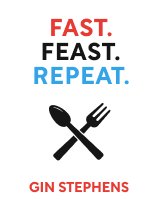

This article is an excerpt from the Shortform book guide to "Fast. Feast. Repeat." by Gin Stephens. Shortform has the world's best summaries and analyses of books you should be reading.
Like this article? Sign up for a free trial here .
Are you considering adopting intermittent fasting (IF) as a lifestyle? What are some things you should keep in mind when beginning your transition to the IF feeding schedule?
Transitioning to intermittent fasting (IF) is a big step, especially if you’re used to following the standard three-meal feeding approach. According to Gin Stephens, the author of Fast. Feast. Repeat., the key to successfully transitioning to the IF lifestyle is to adapt your body to the IF feeding over a four-week period.
Keep reading to learn how to start fasting by committing to a four-week adaptation period.
Commit to a Four-Week Quickstart
If you want to know how to start fasting, Gin Stephens lays out a four-week program during which you’ll adapt to IF by depleting your glycogen stores and teaching your body to access your fat stores. While adapting, be consistent and patient. Follow through with the full four weeks once you start. If you dabble, your body will struggle to adapt and you’ll delay the benefits of IF.
Keep your fasting clean: Follow Stephens’s clean fasting guidelines to teach your body to access its fat stores. You’ll gradually deplete your stored glycogen and cue your body to search for an alternate source of fuel—your fat.
Do not change what you eat during this four-week period. Adapting to IF is a large change, and another—such as diet change—can overwhelm you and hinder the process.
| Build the IF Habit While Stephens gives plenty of information about fasting, she doesn’t dive into how you can successfully change your behavior. In Tiny Habits, BJ Fogg explains that successful behavioral change occurs when you have sufficient motivation, ability, and a prompt that gets you started. He explains this as Behavior = MAP. The core of Fogg’s approach is to make the change as small as possible. He argues that motivation is unreliable, so we need to make sure our new behaviors are small enough that we won’t find excuses to avoid them. Create a “tiny habit” by finding just the first step of the behavior you want to learn—for instance, putting on your socks and shoes to start a running habit. For intermittent fasting, you might commit to one day of fasting and build momentum from there. Lastly, celebrate your success each time you perform the new behavior. According to Fogg, this reinforces the behavior in your brain and helps make it automatic. Plus, feeling good about yourself is healthy for its own sake. |
Stephens offers three approaches to begin fasting: An easy, medium, and hard approach. In each, you’ll build from shorter fasts and longer feasts to longer fasts and shorter feasts. Below, we’ve notated the fast/feast windows with the x:y ratios explained in “How to Time Your Fasts.” Pick one and follow the fasting/feasting patterns prescribed for each week.
- Approach #1: Easy—In week one, 12:12. In week two, 14:10. In week three, 16:8. In week four, 18:6.
- Approach #2: Medium—In week one, 16:8. In week two, 17:7. In week three, 18:6. In week four, 19:5.
- Approach #3: Hard—In weeks one and two, 18:6. In week three, 19:5. In week four, 20:4.
(Shortform note: In Tiny Habits, Fogg also argues that we should treat behavioral change as a scientific experiment instead of a judgment of motivation or willpower. If the approach you choose is too tough, consider that you might’ve asked yourself to make too big a change with too little motivation, ability, or no good prompt. Reflect on what didn’t work, and then use Fogg’s technique: Brainstorm several behaviors that could help you adapt to IF, and pick the “golden behavior”—the option that’s both feasible and impactful.)
Common Changes While Adapting
Once you begin, your body needs to get used to fasting instead of having the glucose from consistent eating. When that glucose isn’t available, you might experience lethargy, headaches, and fatigue. This means your body is depleting your glycogen stores. After a few weeks (usually three to four, or eight at most), you’ll experience heightened energy and ease during your fasts.
Stephens stresses that it’s fine if you get hungry during your fast—this happens to everyone. Know that hunger tends to come in waves that pass. It won’t build forever or overwhelm you. However, your appetite will likely increase since your body can’t access your fat stores very well yet. Once your body learns to access fat for energy, your appetite will settle down.
(Shortform note: Harvard Health explains that alternate-day fasting causes headaches and lethargy more often than time-restricted eating. If you experience severe pains, they recommend using TRE instead of ADF or fasting less frequently. In addition, they note that fasting often causes overeating since your appetite hormones ramp up while you aren’t eating. To avoid this, they recommend easing into IF by gradually decreasing your eating window over a period of several months—much more gradually than Stephens prescribes.)
Adjust Your Approach
If your first approach doesn’t work out, Stephens recommends you switch to another. If it was too easy, pick a harder plan. If it was too hard, pick an easier plan.
(Shortform note: While Stephens suggests an evening eating window, other studies indicate that a morning eating window may be better. Research found that people’s cognition and memory were stronger when they’d eaten breakfast. Those who fasted early in the day also struggled to exercise on an empty stomach, and eating late has been linked to weight gain.)
After finishing the four-week adaptation period, you can further adjust your approach. Stephens explains that it’s up to you to customize your fasting lifestyle and find what works best. This is as simple as trying out different fasting rhythms, paying attention to how you feel, and adjusting until you feel great.
Each time you make an adjustment, give your body at least two weeks to adjust before judging how something works for you. Listen to your body’s signals—if you feel great, that’s a good sign. If you feel moody or nauseous, try adjusting your approach again.
(Shortform note: In The 4-Hour Body, Tim Ferriss argues that self-experimentation is the best route to knowing yourself. By experimenting extensively with his diet, exercise habits, and more, he learned how to rapidly build muscle, improve his sleep, and lengthen his life. Ferriss recommends finding the “minimum effective dose” to change something in your life, and he advises changing only one aspect of your lifestyle at a time.)
Lose Weight With Intermittent Fasting
Let’s look at how to start wasting for the purpose of weight loss. We’ll cover measurement tactics, how to overcome plateaus, and how to maintain your weight once you reach your goals.
According to Stephens, you will not experience rapid weight loss with IF. Instead, expect that your body will take time to adjust and know that weight loss will ramp up over time. In addition, intermittent fasting doesn’t produce linear weight loss due to body recomposition. You’ll lose fat and gain muscle due to increased human growth hormone. Because muscle weighs more than fat by volume, you’ll drop sizes while remaining heavier than you expected.
(Shortform note: Intuitive Eating recommends putting weight loss on hold and first reclaiming a healthy relationship with food. If you lose weight as a consequence of eating more intuitively, that’s wonderful. But if you focus on weight loss rather than getting back in tune with your body’s natural signals, you aren’t truly losing a dieting mindset.)
Use at least one of the following measurement tactics to track your progress:
- Tactic #1: Calculate your average weight loss. If fat loss is your main goal, track it by calculating your weekly average drop in weight. This shows you the trend of your weight loss—it’ll go steadily downward, even if daily numbers fluctuate. If weighing stresses you out, Stephens says you can drop the scale altogether and rely on other measurements.
- Tactic #2: Use “goal” clothing. Buy a pair of pants that you’d like to fit into—a size or two down—and check each week to see how they fit. Once they fit, you know you’ve made progress, and you can aim to drop another size or two.
- Tactic #3: Take regular photos. Wearing the same clothes each time, take weekly pictures from the front, back, and sides. By comparing these, you’ll see clearly the progress you’ve made.
Overcome Plateaus by Adjusting
Stephens explains that as you lose weight, your body might settle into a new set point—a default weight that your body wants to maintain—and resist further weight loss. When this occurs, the solution is usually to adjust your fasting or your feasting.
- Adjust your fasting. First, make sure you’re fasting cleanly. Second, switch up your fasting rhythms: Try going from TRE to ADF, changing the length of your fasting window, or adjusting when you fast and when you feast.
- Adjust your feasting. Recognize if you’re overeating or eating too many ultra-processed foods, and try delaying these foods for a month or two. In addition, try switching up your eating style by getting more whole foods or adjusting your macronutrient intake.
Maintain Your Weight
Once you’ve approached your goal weight, Stephens recommends choosing a “goal body” to maintain. Your weight will naturally fluctuate a bit, so stressing about maintaining an exact number isn’t helpful. Instead, trust that your body will reach a healthy weight and stay there.
To maintain your goal body, keep up with good IF habits. If you gain weight, check your eating habits and adjust them a bit to settle back down. If you lose too much, eat a bit more. It’s okay to enjoy a bit more food from time to time, and it’s okay to eat less when you need to.
You can also use your “goal” clothing to keep perspective. If you still fit in your goal pants, you’re doing fine. If you feel a little tight in them, that’s a gentle signal to ease back a bit on the feasting.

———End of Preview———
Like what you just read? Read the rest of the world's best book summary and analysis of Gin Stephens's "Fast. Feast. Repeat." at Shortform .
Here's what you'll find in our full Fast. Feast. Repeat. summary :
- How intermittent fasting can help you lose weight, feel better, fight disease, and live longer
- An explanation of the cutting-edge science that supports fasting
- How to follow a four-week quickstart program to adapt to this new lifestyle






